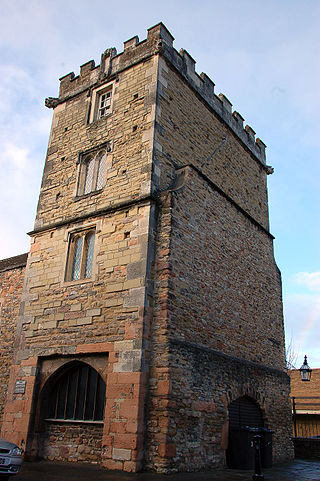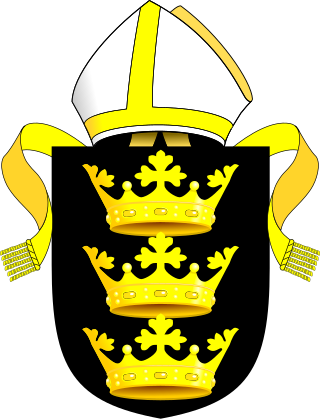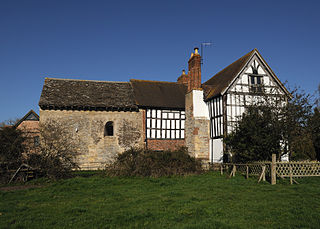John Barlow was a member of Henry VIII's Protestant Church as Dean of Worcester Cathedral. During the king's search for an annulment to his first marriage, Barlow acted as a courier between England and Italy, while Rector of Hever.

Bristol Cathedral, formally the Cathedral Church of the Holy and Undivided Trinity, is a Church of England cathedral in the city of Bristol, England. It is the seat of the Bishop of Bristol. The cathedral was originally an abbey dedicated to St Augustine, founded in 1140 and consecrated in 1148. It became the cathedral of the new diocese of Bristol in 1542, after the dissolution of the monasteries. It is a Grade I listed building.

Aust is a small village in South Gloucestershire, England, about 10 miles (16 km) north of Bristol and about 28 miles (45 km) south west of Gloucester. It is located on the eastern side of the Severn estuary, close to the eastern end of the Severn Bridge which carries the M48 motorway. The village has a chapel, a church and a public house. There is a large area of farmland on the river bank, which is sometimes flooded due to the high tidal range of the Severn. Aust Cliff, above the Severn, is located about 0.5 miles (0.80 km) from the village. The civil parish of Aust includes the villages of Elberton and Littleton-upon-Severn.

Henbury is a suburb of Bristol, England, approximately 5 miles (8.0 km) north west of the city centre. It was formerly a village in Gloucestershire and is now bordered by Westbury-on-Trym to the south; Brentry to the east and the Blaise Castle Estate, Blaise Hamlet and Lawrence Weston to the west. To the north lie the South Gloucestershire village of Hallen and the entertainment/retail park Cribbs Causeway.

The Diocese of Worcester forms part of the Church of England (Anglican) Province of Canterbury in England.

Westbury on Trym is a suburb and council ward in the north of the City of Bristol, near the suburbs of Stoke Bishop, Westbury Park, Henleaze, Southmead and Henbury, in the southwest of England.

Westbury College Gatehouse is a 15th-century gatehouse to the 13th-century College of Priests located in Westbury-on-Trym, Bristol, England, and now a National Trust property.

The Diocese of Bristol is an ecclesiastical jurisdiction or diocese of the Church of England in the Province of Canterbury, England. It is based in the city of Bristol and covers South Gloucestershire and parts of north Wiltshire, as far east as Swindon. The diocese is headed by the Bishop of Bristol and the Episcopal seat is located at the Cathedral Church of the Holy and Undivided Trinity, commonly known as Bristol Cathedral.

Odda's Chapel is a former chantry chapel at Deerhurst, Gloucestershire. It is an 11th-century late Anglo-Saxon building, completed a decade before the Norman Conquest of England.

Holy Trinity Church, Kingswood, is an Anglican parish church in Kingswood, South Gloucestershire, England. It has been designated as a grade II* listed building.

St Mary the Virgin is a Church of England parish church in Henbury, Bristol, England.

Robert Fitzharding was an Anglo-Saxon nobleman from Bristol who was granted the feudal barony of Berkeley in Gloucestershire. He rebuilt Berkeley Castle, and founded the Berkeley family which still occupies it today. He was a wealthy Bristol merchant and a financier of the future King Henry II of England (1133-1189) in the period known as the Anarchy during which Henry's mother, the Empress Matilda (1102-1167), mounted repeated military challenges to King Stephen. Fitzharding founded St. Augustine's Abbey, which after the Reformation became Bristol Cathedral. Many members of the Berkeley family were buried within it, and some of their effigies survive there. As J. Horace Round asserted he was one of the very few Anglo-Saxon noblemen who managed to retain their noble status in Norman England and successfully integrate with the Norman nobility, if not the only one.

Leeds Minster, or the Minster and Parish Church of Saint Peter-at-Leeds is the minster church of Leeds, West Yorkshire, England. It stands on the site of the oldest church in the city and is of architectural and liturgical significance. A church is recorded on the site as early as the 7th century, although the present structure is a Gothic Revival one, designed by Robert Dennis Chantrell and completed in 1841. It is dedicated to Saint Peter and was the Parish Church of Leeds before receiving the honorific title of "Minster" in 2012. It has been designated a Grade I listed building by Historic England.
John Carpenter (1399–1476) was an English bishop, provost, and university chancellor.
St Mary Magdalen Nunnery was a priory of Augustinian canonesses in Kingsdown, Bristol, England. It was founded c. 1173 and dissolved in 1536. St Mary Magdalen is remembered in the name of Maudlin Street; the nunnery was located near to the corner of Maudlin Street and St Michael's Hill, which was later the site of the King David Inn.

Leonard Stanley Priory was a priory in Gloucestershire, England. Over the years following the dissolution most of the buildings of the priory complex have been destroyed.
Astley Priory was a Benedictine priory in Astley, Worcestershire, England.

The Bishop of Bristol heads the Church of England Diocese of Bristol in the Province of Canterbury, in England.

Henbury Hundred was a subdivision of the county of Gloucestershire, England. Hundreds originated in the late Saxon period and lasted as administrative divisions until the 19th century.

















